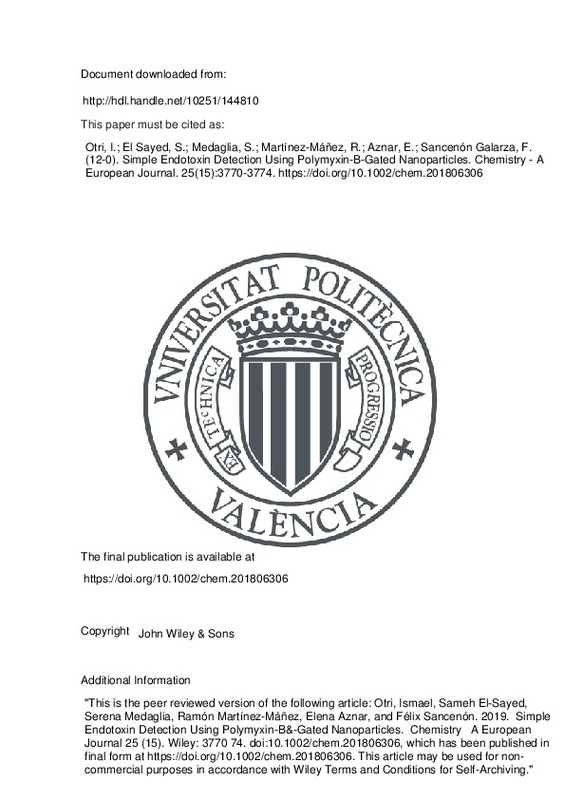Ulevitch, R. J., & Tobias, P. S. (1994). Recognition of endotoxin by cells leading to transmembrane signaling. Current Opinion in Immunology, 6(1), 125-130. doi:10.1016/0952-7915(94)90043-4
YOUNG, L. S. (1977). Gram-Negative Rod Bacteremia: Microbiologic, Immunologic, and Therapeutic Considerations. Annals of Internal Medicine, 86(4), 456. doi:10.7326/0003-4819-86-4-456
Mueller, M., Lindner, B., Kusumoto, S., Fukase, K., Schromm, A. B., & Seydel, U. (2004). Aggregates Are the Biologically Active Units of Endotoxin. Journal of Biological Chemistry, 279(25), 26307-26313. doi:10.1074/jbc.m401231200
[+]
Ulevitch, R. J., & Tobias, P. S. (1994). Recognition of endotoxin by cells leading to transmembrane signaling. Current Opinion in Immunology, 6(1), 125-130. doi:10.1016/0952-7915(94)90043-4
YOUNG, L. S. (1977). Gram-Negative Rod Bacteremia: Microbiologic, Immunologic, and Therapeutic Considerations. Annals of Internal Medicine, 86(4), 456. doi:10.7326/0003-4819-86-4-456
Mueller, M., Lindner, B., Kusumoto, S., Fukase, K., Schromm, A. B., & Seydel, U. (2004). Aggregates Are the Biologically Active Units of Endotoxin. Journal of Biological Chemistry, 279(25), 26307-26313. doi:10.1074/jbc.m401231200
Bhattacharyya, J., Biswas, S., & Datta, A. (2004). Mode of Action of Endotoxin: Role of Free Radicals and Antioxidants. Current Medicinal Chemistry, 11(3), 359-368. doi:10.2174/0929867043456098
Braun-Fahrländer, C., Riedler, J., Herz, U., Eder, W., Waser, M., Grize, L., … von Mutius, E. (2002). Environmental Exposure to Endotoxin and Its Relation to Asthma in School-Age Children. New England Journal of Medicine, 347(12), 869-877. doi:10.1056/nejmoa020057
M. T. Madigan J. M. Martinko J. Parker T. D. Brock Brock Biology of Microorganisms 2000 Prentice Hall Upper Saddle River 793 794
Reynolds, S. J., Milton, D. K., Heederik, D., Thorne, P. S., Donham, K. J., Croteau, E. A., … Larsson, L. (2005). Interlaboratory evaluation of endotoxin analyses in agricultural dusts—comparison of LAL assay and mass spectrometry. Journal of Environmental Monitoring, 7(12), 1371. doi:10.1039/b509256f
Peters, M. (2006). Inhalation of stable dust extract prevents allergen induced airway inflammation and hyperresponsiveness. Thorax, 61(2), 134-139. doi:10.1136/thx.2005.049403
Peters, M., Fritz, P., & Bufe, A. (2012). A bioassay for determination of lipopolysaccharide in environmental samples. Innate Immunity, 18(5), 694-699. doi:10.1177/1753425912436590
Lourenco, F. R., Botelho, T. D. S., & Pinto, T. D. J. A. (2012). How pH, Temperature, and Time of Incubation Affect False-Positive Responses and Uncertainty of the LAL Gel-Clot Test. PDA Journal of Pharmaceutical Science and Technology, 66(6), 542-546. doi:10.5731/pdajpst.2012.00887
Voss, S., Fischer, R., Jung, G., Wiesmüller, K.-H., & Brock, R. (2007). A Fluorescence-Based Synthetic LPS Sensor. Journal of the American Chemical Society, 129(3), 554-561. doi:10.1021/ja065016p
Wu, J., Zawistowski, A., Ehrmann, M., Yi, T., & Schmuck, C. (2011). Peptide Functionalized Polydiacetylene Liposomes Act as a Fluorescent Turn-On Sensor for Bacterial Lipopolysaccharide. Journal of the American Chemical Society, 133(25), 9720-9723. doi:10.1021/ja204013u
Zeng, L., Wu, J., Dai, Q., Liu, W., Wang, P., & Lee, C.-S. (2010). Sensing of Bacterial Endotoxin in Aqueous Solution by Supramolecular Assembly of Pyrene Derivative. Organic Letters, 12(18), 4014-4017. doi:10.1021/ol1016228
Lan, M., Wu, J., Liu, W., Zhang, W., Ge, J., Zhang, H., … Wang, P. (2012). Copolythiophene-Derived Colorimetric and Fluorometric Sensor for Visually Supersensitive Determination of Lipopolysaccharide. Journal of the American Chemical Society, 134(15), 6685-6694. doi:10.1021/ja211570a
Dullah, E. C., & Ongkudon, C. M. (2016). Current trends in endotoxin detection and analysis of endotoxin–protein interactions. Critical Reviews in Biotechnology, 37(2), 251-261. doi:10.3109/07388551.2016.1141393
Prasad, P., Sachan, S., Suman, S., Swayambhu, G., & Gupta, S. (2018). Regenerative Core–Shell Nanoparticles for Simultaneous Removal and Detection of Endotoxins. Langmuir, 34(25), 7396-7403. doi:10.1021/acs.langmuir.8b00978
Jurado-Sánchez, B., Pacheco, M., Rojo, J., & Escarpa, A. (2017). Magnetocatalytic Graphene Quantum Dots Janus Micromotors for Bacterial Endotoxin Detection. Angewandte Chemie International Edition, 56(24), 6957-6961. doi:10.1002/anie.201701396
Jurado-Sánchez, B., Pacheco, M., Rojo, J., & Escarpa, A. (2017). Magnetocatalytic Graphene Quantum Dots Janus Micromotors for Bacterial Endotoxin Detection. Angewandte Chemie, 129(24), 7061-7065. doi:10.1002/ange.201701396
Ahn, G., Sekhon, S. S., Jeon, Y.-E., Kim, M.-S., Won, K., Kim, Y.-H., & Ahn, J.-Y. (2017). Detection of endotoxins using nanomaterials. Toxicology and Environmental Health Sciences, 9(5), 259-268. doi:10.1007/s13530-017-0330-4
Sancenón, F., Pascual, L., Oroval, M., Aznar, E., & Martínez-Máñez, R. (2015). Gated Silica Mesoporous Materials in Sensing Applications. ChemistryOpen, 4(4), 418-437. doi:10.1002/open.201500053
Aznar, E., Oroval, M., Pascual, L., Murguía, J. R., Martínez-Máñez, R., & Sancenón, F. (2016). Gated Materials for On-Command Release of Guest Molecules. Chemical Reviews, 116(2), 561-718. doi:10.1021/acs.chemrev.5b00456
El Sayed, S., Giménez, C., Aznar, E., Martínez-Máñez, R., Sancenón, F., & Licchelli, M. (2015). Highly selective and sensitive detection of glutathione using mesoporous silica nanoparticles capped with disulfide-containing oligo(ethylene glycol) chains. Organic & Biomolecular Chemistry, 13(4), 1017-1021. doi:10.1039/c4ob02083a
Ribes, À., Santiago-Felipe, S., Aviñó, A., Candela-Noguera, V., Eritja, R., Sancenón, F., … Aznar, E. (2018). Design of oligonucleotide-capped mesoporous silica nanoparticles for the detection of miRNA-145 by duplex and triplex formation. Sensors and Actuators B: Chemical, 277, 598-603. doi:10.1016/j.snb.2018.09.026
Ribes, À., Xifré -Pérez, E., Aznar, E., Sancenón, F., Pardo, T., Marsal, L. F., & Martínez-Máñez, R. (2016). Molecular gated nanoporous anodic alumina for the detection of cocaine. Scientific Reports, 6(1). doi:10.1038/srep38649
Mondragón, L., Mas, N., Ferragud, V., de la Torre, C., Agostini, A., Martínez-Máñez, R., … Orzáez, M. (2014). Enzyme-Responsive Intracellular-Controlled Release Using Silica Mesoporous Nanoparticles Capped with ε-Poly-L-lysine. Chemistry - A European Journal, 20(18), 5271-5281. doi:10.1002/chem.201400148
Wang, Y., Zhang, D., Liu, W., Zhang, X., Yu, S., Liu, T., … Wang, J. (2014). Facile colorimetric method for simple and rapid detection of endotoxin based on counterion-mediated gold nanorods aggregation. Biosensors and Bioelectronics, 55, 242-248. doi:10.1016/j.bios.2013.12.006
Su, W., Cho, M., Nam, J.-D., Choe, W.-S., & Lee, Y. (2013). Aptamer-Assisted Gold Nanoparticles/PEDOT Platform for Ultrasensitive Detection of LPS. Electroanalysis, 25(2), 380-386. doi:10.1002/elan.201200453
[-]







![[Cerrado]](/themes/UPV/images/candado.png)


